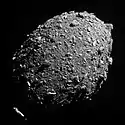GRB 221009A
GRB 221009A also known as Swift J1913.1+1946 was an unusually bright and long-lasting gamma-ray burst (GRB) jointly discovered by the Neil Gehrels Swift Observatory and the Fermi Gamma-ray Space Telescope on October 9, 2022. The gamma-ray burst was around seven minutes long,[1] but was detectable for more than ten hours following initial detection,[2][3] and for several hours was bright enough in visible frequencies to be observable by amateur astronomers.[4] Despite being over 2 billion light-years away, it was powerful enough to affect Earth's atmosphere, having the strongest effect ever recorded by a gamma-ray burst on the planet.[5][6][7] The peak luminosity of GRB 221009A was measured by Konus-Wind to be ∼ 2.1 × 1047 J/s and by Fermi-GBM to be ∼ 1.0 × 1047 J/s over the 1.024s interval.[8] A burst as energetic and as close to Earth as 221009A is thought to be a once-in-10,000-year event.[9][8] It was the brightest and most energetic gamma-ray burst ever recorded, being deemed the "BOAT", or brightest of all time.[8][10][11]
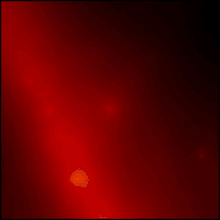 Ten-hour timelapse of GRB 221009A, as seen by the Fermi Gamma-ray Space Telescope | |
| Constellation | Sagitta |
|---|---|
| Right ascension | 19h 13m 03.48s |
| Declination | +19° 46′ 24.6″ |
| Distance | 2.4 billion light years |
| Redshift | 0.151 |
| Other designations | Swift J1913.1+1946,SN 2022xiw |
| | |
Characterization
GRB 221009A came from the constellation of Sagitta and occurred an estimated 1.9 billion years ago,[12] however its source is now 2.4 billion light-years away from Earth due to the expansion of the universe during the time-of-flight to Earth.[13] The burst's high-intensity emissions spanned 15 orders of magnitude on the electromagnetic spectrum, from radio emissions to gamma rays. Radio signals broadcast by the winding down of whatever process created the initial burst will likely linger for years to come.[14] This broadband emission offers the rare opportunity to study normally-fleeting GRBs in great detail.[12][14]
Observation
The burst saturated the Fermi Gamma-ray Space Telescope's detector,[15] which captured gamma ray photons with energies exceeding 100 GeV.[16] GRB 221009A is by far the most productive event for very high energy (VHE) photons ever witnessed by scientific instrumentation. Before GRB 221009A, the number of very high-energy photons detected over the entire history of GRB astronomy numbered only a few hundred. When the burst's radiation arrived at Earth the Large High Altitude Air Shower Observatory (LHAASO) alone saw more than 5,000 such VHE photons. Some of these photons arrived at Earth carrying a record 18 TeV of energy,[17][4] more than can be produced at the Large Hadron Collider (LHC) at the European Center for Nuclear Research (CERN).[18][11] Russia's Carpet-2 facility at the Baksan Neutrino Observatory may have also recorded a single 251-TeV photon from this burst.[15] These detected energies are far more than GRB 190114C, which had up to 1 TeV of energy,[19] which was deemed to have been the biggest explosion since the Big Bang,[20] or GRB 190829A, which had up to 3.3 TeV of energy,[21] being the first and only GRB so far to have photons above 10 TeV.[22][23] The burst possibly had the signature of accelerating ultra-high-energy cosmic rays for the first time.[24]
GRB 221009A was subsequently observed by the Neutron Star Interior Composition Explorer (NICER),[12] The Monitor of All-sky X-ray Image (MAXI), the Imaging X-ray Polarimetry Explorer (IXPE),[25][26][7] The International Gamma-ray Astrophysics Laboratory (INTEGRAL), the XMM-Newton space telescope,[27] The Large High Altitude Air Shower Observatory (LHASSO)[28][29] and many others.[18][30]
Possible causes
GRB 221009A may have been caused by a massive star undergoing a supernova,[4] or by the birth of a black hole.[16] Supernovae often lead to the formation of a black hole if the parent star is too massive for stable neutron star formation, and it is not yet known which part of, or whether, the death of a star was responsible for this gamma-ray burst. Some physicists speculate that the exceptionally high-energy photons observed during 221009A could be the result of previously theoretical or unknown physical processes involving dark matter,[15] axions, or decaying sterile neutrinos.[31] As yet there is no conclusive evidence that this gamma-ray burst was caused by a supernova;[32][33][34][35] nor have any of the enormous number of neutrinos emitted by supernovae been detected.[36] Lightning detectors in India and Germany picked up signs that the Earth's ionosphere was perturbed for several hours by the burst, though only mildly,[37][15][5] as well as an enormous influx of electrically charged particles,[38] showing just how powerful it was.[39][11] It also disrupted longwave radio communications.[40] It had the strongest affect ever recorded by a gamma-ray burst on the planet.[5] Further, the relativistic jet of this gamma-ray burst has an unusual structure.[41][42]
Record magnitude
Some astronomers referred to the burst as the "brightest of all time", or by the acronym "BOAT".[15][43] This claim is easily justified by the record of known gamma-ray bursts.[8] Dan Perley, an astrophysicist at the Astrophysics Research Institute at Liverpool John Moores University, stated "There is nothing in human experience that comes anywhere remotely close to such an outpouring of energy. Nothing."[44] Eric Burns, an astronomer at Louisiana State University, also stated about the energy of the burst that "The energy of this thing is so extreme that if you took the entire Sun and you converted all of it into pure energy, it still wouldn’t match this event. There’s just nothing comparable."[45] The power of gamma-ray bursts may be gauged by the degree of interaction between the gamma rays they emit and the ubiquitous lanes of interstellar dust in deep space. Such interactions generate an afterglow in X-ray frequencies, usually seen as concentric rings of scattered X-rays with the gamma ray burst at the center. GRB 221009A is only the seventh gamma-ray burst known to have generated these rings.[9] The X-ray afterglow of 221009A was around a thousand times brighter than the typical GRB,[39] and as of June 2023 a record twenty X-ray afterglow rings had been identified around the burst.[46][9] The burst had the brightest X-ray afterglow ever recorded,[41] and the brightest UVOT afterglow ever recorded once corrected for extinction.[47] It had the largest amount of energy ever recorded in the TeV range,[48] and had the most energetic photons ever recorded for a GRB, peaking at 18 TeV.[22][17] The burst was ten times brighter than any previous GRB detected by the Swift mission.[49] It was the brightest and most intense GRB detected by KONUS-Wind.[50] The prompt emission of the burst far surpassed anything before it, far exceeding four previous GRB record-holders, as no GRB had been recorded delivering more than 500,000 gamma-ray photons-per-second, yet this GRB peaked at over 6 million photons-per-second.[51][52] The burst was so bright that it blinded most gamma-ray instruments in space, preventing a true recording of its intensity.[9][53] It was even detected by satellites not designed to detect gamma-ray bursts, such as Voyager 1.[7]
It is considered the largest explosion ever recorded by mankind, and the largest since the Big Bang.[54][55]
Relevance to new physics
Through comparison of data collected by different observatories scientists concluded that the 221009A event was 50 to 70 times brighter than the previous record holder, along with it being far more energetic than the previous record holder.[30][9][42][10] The extremely bright peak and long afterglow may help physicists study the manner in which matter interacts at relativistic speeds, the only known regime capable of generating gamma ray photons with more then 100 GeV of energy.[12] Study of 221009A and similarly extreme events are at present humanity's only access to particles with energies larger than any that can be generated artificially. The close examination of 221009A may eventually yield physical explanations that are neither predicted by nor accounted for in the Standard Model.[15] It has become the most studied gamma-ray burst in history.[56]
Gallery
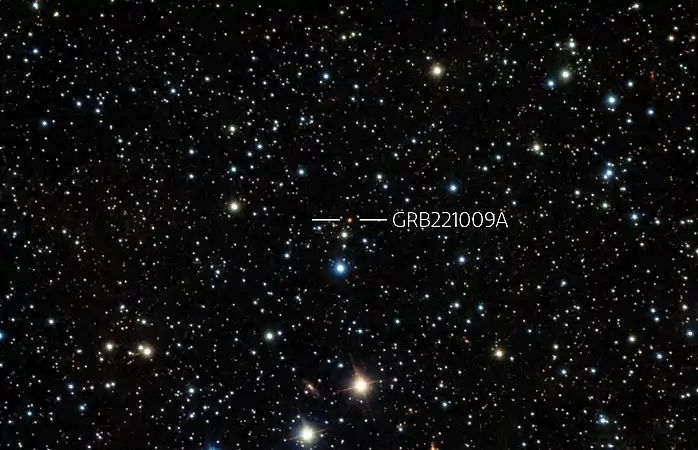 Near-simultaneous observations were made of GRB221009A from Gemini South in Chile. The image is a combination of 4 exposures in I, J, H, K with two instruments taken in the morning of Friday, October 14, 2022.[57]
Near-simultaneous observations were made of GRB221009A from Gemini South in Chile. The image is a combination of 4 exposures in I, J, H, K with two instruments taken in the morning of Friday, October 14, 2022.[57]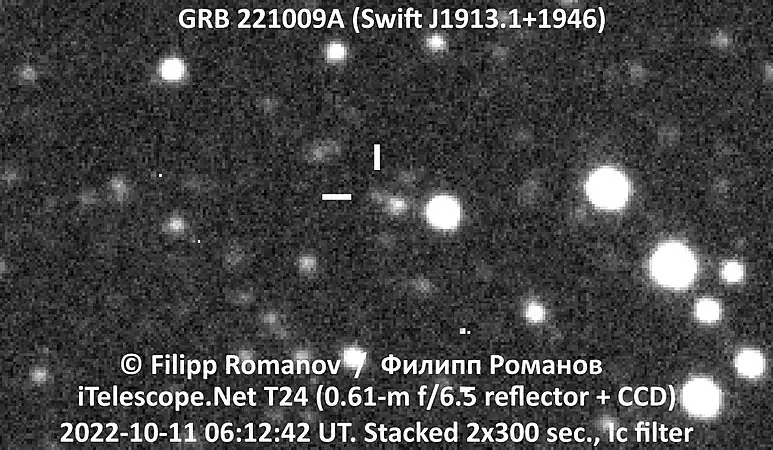 Optical afterglow of GRB 221009A imaged by amateur astronomer using remote telescope
Optical afterglow of GRB 221009A imaged by amateur astronomer using remote telescope
![Swift's X-ray image of GRB 221009A shows circular rings around the gamma-ray burst. Dust in the Milky Way scattered the x-ray emission of the gamma-ray burst, creating the rings.[29]](../I/Xrt_image_crop.jpg.webp)
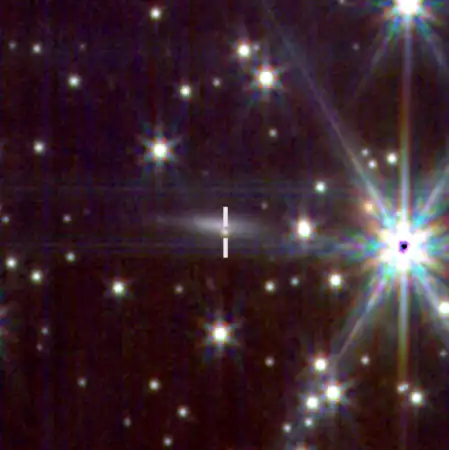 Near-infrared afterglow and host seen by Webb's NIRCam.
Near-infrared afterglow and host seen by Webb's NIRCam.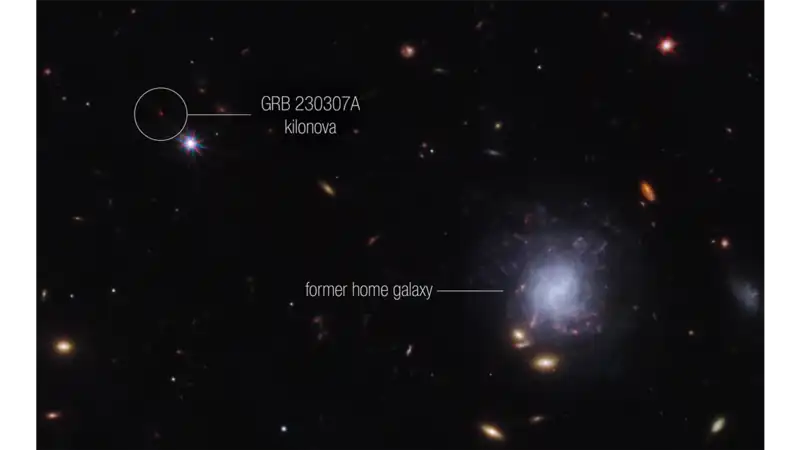 Near-infrared afterglow and host galaxy Second brightest gamma-ray GRB 230307A burst photographed by Webb, for comparison.
Near-infrared afterglow and host galaxy Second brightest gamma-ray GRB 230307A burst photographed by Webb, for comparison.
See also
- List of gamma-ray bursts
- Gamma-ray astronomy
- GRB 230307A Second-brightest gamma-ray burst
References
- Reddy, Francis (May 31, 2023). "NASA Looks Back at 50 Years of Gamma-Ray Burst Science". NASA. Retrieved September 23, 2023.
- Dichiara, S.; Gropp, J. D.; Kennea, J. A.; Kuin, N. P. M.; Lien, A. Y.; Marshall, F. E.; Tohuvavohu, A.; Williams, M. A.; Neil Gehrels Swift Observatory Team (2022). "Swift J1913.1+1946 a new bright hard X-ray and optical transient". The Astronomer's Telegram. 15650: 1. Bibcode:2022ATel15650....1D.
- Starr, Michelle (October 12, 2022). "Scientists Just Detected a Colossal Gamma-Ray Burst, And It's a Record-Breaker". ScienceAlert. Retrieved October 14, 2022.
- Ahmed, Issam (October 16, 2022). "Astronomers are captivated by brightest flash ever seen". AFP. Phys.org.
- Hayes, Laura A.; Gallagher, Peter T. (2023). "A Significant Sudden Ionospheric Disturbance Associated with Gamma-Ray Burst GRB 221009A". Research Notes of the AAS. American Astronomical Society. 6 (10): 222. arXiv:2210.15284. doi:10.3847/2515-5172/ac9d2f. S2CID 253157644.
- Crane, Leah (October 17, 2022). "Astronomers have just watched the most powerful explosion ever seen". New Scientist. Retrieved September 29, 2023.
- Hensley, Kerry (March 29, 2023). "Focusing on the Brightest Gamma-ray Burst of All Time". AAS Nova. Retrieved April 12, 2023.
- Burns, Eric; et al. (2023). "GRB 221009A: The BOAT". The Astrophysical Journal Letters. 946 (1): L31. arXiv:2302.14037. Bibcode:2023ApJ...946L..31B. doi:10.3847/2041-8213/acc39c. S2CID 257219686.
- Reddy, Francis (March 28, 2023). "NASA Missions Study What May Be a 1-In-10,000-Year Gamma-ray Burst". NASA. Retrieved March 29, 2023.
- Ionescu, Andrei (June 11, 2023). "Recent gamma-ray burst was 70 times brighter than any cosmic explosion". Earth.com. Retrieved September 17, 2023.
- Lincoln, Don (June 13, 2023). "Explaining GRB 221009A, the greatest cosmic explosion humanity has ever seen". Big Think. Retrieved September 17, 2023.
- Reddy, Francis (October 13, 2022). "NASA's Swift, Fermi Missions Detect Exceptional Cosmic Blast". NASA’s Goddard Space Flight Center.
- Dickinson, David (April 6, 2023). "Brightest Gamma-ray Burst Shines Light on Milky Way Structure". Universe Today. Retrieved June 15, 2023.
- Laskar, Tanmoy; et al. (2023). "The Radio to GeV Afterglow of GRB 221009A". The Astrophysical Journal Letters. 946 (1): L23. arXiv:2302.04388. Bibcode:2023ApJ...946L..23L. doi:10.3847/2041-8213/acbfad. S2CID 256697486.
- O'Callaghan, Jonathan (October 26, 2022). "Brightest-Ever Space Explosion Could Help Explain Dark Matter". Quanta Magazine. Retrieved October 27, 2022.
- Nemiroff, Robert; Jerry, Bonnell (October 15, 2022). "GRB 221009A". Astronomy Picture of the Day. NASA. Retrieved January 12, 2023.
- Sahu, Sarira; Medina-Carrillo, B.; Sánchez-Colón, G.; Rajpoot, Subhash (2023). "Deciphering the ~18 TeV Photons from GRB 221009A". The Astrophysical Journal Letters. 942 (L30): L30. arXiv:2211.04057. Bibcode:2023ApJ...942L..30S. doi:10.3847/2041-8213/acac2f. S2CID 253397820.
- Sullivan, Will (October 21, 2022). "This Powerful Gamma-Ray Blast Was the 'Brightest of All Time'". Smithsonian Magazine. Retrieved January 12, 2023.
- MAGIC Collaboration; Acciari, V. A.; Ansoldi, S.; Antonelli, L. A.; Engels, A. Arbet; Baack, D.; Babić, A.; Banerjee, B.; de Almeida, U. Barres; Barrio, J. A.; González, J. Becerra; Bednarek, W.; Bellizzi, L.; Bernardini, E.; Berti, A. (November 21, 2019). "Teraelectronvolt emission from the gamma-ray burst GRB 190114C". Nature. 575 (7783): 455–458. doi:10.1038/s41586-019-1750-x. ISSN 0028-0836.
- Wood, Tom (November 22, 2019). "Scientists Detect Biggest Explosion In The Universe Since The Big Bang". LADbible. Retrieved September 18, 2023.
- H.E.S.S. Collaboration; Abdalla, H.; Aharonian, F.; Ait Benkhali, F.; Angüner, E. O.; Arcaro, C.; Armand, C.; Armstrong, T.; Ashkar, H.; Backes, M.; Baghmanyan, V.; Barbosa Martins, V.; Barnacka, A.; Barnard, M.; Becherini, Y. (June 4, 2021). "Revealing x-ray and gamma ray temporal and spectral similarities in the GRB 190829A afterglow". Science. 372 (6546): 1081–1085. doi:10.1126/science.abe8560. ISSN 0036-8075.
- Huang, Yong; Hu, Shicong; Chen, Songzhan; Zha, Min; Liu, Cheng; Yao, Zhiguo; Cao, Zhen; Experiment, The Lhaaso (October 1, 2022). "LHAASO observed GRB 221009A with more than 5000 VHE photons up to around 18 TeV". GRB Coordinates Network. 32677: 1.
- "TeV photons challenge standard explanations". CERN Courier. March 1, 2023. Retrieved October 1, 2023.
- Das, Saikat; Razzaque, Soebur (February 1, 2023). "Ultrahigh-energy cosmic-ray signature in GRB 221009A". Astronomy & Astrophysics. 670: L12. doi:10.1051/0004-6361/202245377. ISSN 0004-6361.
- Maginot, Hannah (December 29, 2022). "NASA's IXPE Quickly Observes Aftermath of Incredible Cosmic Blast – "This Is Now or Never"". SciTech Daily. Retrieved January 12, 2023.
- Negro, Michela; Di Lalla, Niccolò; Omodei, Nicola; Veres, Péter; Silvestri, Stefano; Manfreda, Alberto; Burns, Eric; Baldini, Luca; Costa, Enrico; Ehlert, Steven R.; Kennea, Jamie A.; Liodakis, Ioannis; Marshall, Herman L.; Mereghetti, Sandro; Middei, Riccardo (March 1, 2023). "The IXPE View of GRB 221009A". The Astrophysical Journal Letters. 946 (1): L21. arXiv:2301.01798. Bibcode:2023ApJ...946L..21N. doi:10.3847/2041-8213/acba17. ISSN 2041-8205. S2CID 255440524.
- "ESA spacecraft catch the brightest ever gamma-ray burst". European Space Agency. October 21, 2022. Retrieved January 12, 2023.
- LHAASO Collaboration*†; Cao, Zhen; Aharonian, F.; An, Q.; Axikegu; Bai, L. X.; Bai, Y. X.; Bao, Y. W.; Bastieri, D.; Bi, X. J.; Bi, Y. J.; Cai, J. T.; Cao, Q.; Cao, W. Y.; Cao, Zhe (June 30, 2023). "A tera–electron volt afterglow from a narrow jet in an extremely bright gamma-ray burst". Science. 380 (6652): 1390–1396. arXiv:2306.06372. doi:10.1126/science.adg9328. ISSN 0036-8075.
- Thwaites, Jessie (July 13, 2023). "LHAASO-ing the brightest gamma-ray burst". Astrobites.
- Chinese Academy of Sciences (March 28, 2023). "Insight-HXMT and GECAM-C observations of the brightest-of-all-time GRB 221009A". Phys.org. Retrieved March 29, 2023.
- Smirnov, A.Y.; Trautner, A. (2022). "GRB 221009A Gamma Rays from Radiative Decay of Heavy Neutrinos?". arXiv:2211.00634 [hep-ph].
- Shrestha, Manisha; et al. (2023). "Limit on Supernova Emission in the Brightest Gamma-Ray Burst, GRB 221009A". The Astrophysical Journal Letters. 946 (1): L25. arXiv:2302.03829. Bibcode:2023ApJ...946L..25S. doi:10.3847/2041-8213/acbd50. S2CID 257405480.
- Fulton, M. D.; et al. (2023). "The Optical Light Curve of GRB 221009A: The Afterglow and the Emerging Supernova". The Astrophysical Journal Letters. 946 (1): L22. arXiv:2301.11170. Bibcode:2023ApJ...946L..22F. doi:10.3847/2041-8213/acc101. S2CID 257687906.
- Levan, A. J.; et al. (2023). "The First JWST Spectrum of a GRB Afterglow: No Bright Supernova in Observations of the Brightest GRB of all Time, GRB 221009A". The Astrophysical Journal Letters. 946 (1): L28. arXiv:2302.07761. Bibcode:2023ApJ...946L..28L. doi:10.3847/2041-8213/acc2c1. S2CID 256868610.
- Srinivasaragavan, Gokul P.; et al. (2023). "A Sensitive Search for Supernova Emission Associated with the Extremely Energetic and Nearby GRB 221009A". Astrophysical Journal Letters. 949 (2): L39. arXiv:2303.12849. Bibcode:2023ApJ...949L..39S. doi:10.3847/2041-8213/accf97. S2CID 257687577.
- Abbasi, R.; et al. (2023). "Limits on Neutrino Emission from GRB 221009A from MeV to PeV Using the IceCube Neutrino Observatory". The Astrophysical Journal Letters. 946 (1): L26. arXiv:2302.05459. Bibcode:2023ApJ...946L..26A. doi:10.3847/2041-8213/acc077. S2CID 256827599.
- Plait, Phil (October 21, 2022). "The Brightest Gamma-Ray Burst Ever Recorded Rattled Earth's Atmosphere". Scientific American.
- Battiston, R.; et al. (2023). "Observation of Anomalous Electron Fluxes Induced by GRB221009A on CSES-01 Low-energy Charged Particle Detector". The Astrophysical Physics Journal Letters. 946 (1): L29. Bibcode:2023ApJ...946L..29B. doi:10.3847/2041-8213/acc247. S2CID 257801868.
- Japelj, Jure (October 17, 2023). "BRIGHTEST GAMMA-RAY BURST YET LIGHTS UP THE SKY". Sky & Telescope. Retrieved September 17, 2023.
- Pultarova, Tereza (October 18, 2022). "Most powerful gamma-ray burst ever seen could help reveal how black holes are born". Space.com. Retrieved September 23, 2023.
- O'Connor, Brennan; et al. (June 7, 2023). "A structured jet explains the extreme GRB 221009A". Science Advances. 9 (23). doi:10.1126/sciadv.adi1405. PMC 10246904.
- Greicius, Tony (June 8, 2023). "Brightest Cosmic Explosion Ever Detected Had Other Unique Features". NASA. Retrieved July 1, 2023.
- Miller, Katrina (October 2022). "The 'Brightest of All Time' Gamma-Ray Burst Sparks a Supernova Hunt". Wired. Retrieved October 27, 2022.
- Ambrose, Tom (March 28, 2023). "Cosmic explosion last year may be 'brightest ever seen'". The Guardian. ISSN 0261-3077. Retrieved September 27, 2023.
- Ouellette, Jennifer (March 30, 2023). "Brightest-ever gamma-ray burst (the "BOAT") continues to puzzle astronomers". Ars Technica. Retrieved September 17, 2023.
- Tiengo, Andrea; et al. (2023). "The Power of the Rings: The GRB 221009A Soft X-Ray Emission from Its Dust-scattering Halo". The Astrophysical Journal Letters. 946 (1): L30. arXiv:2302.11518. Bibcode:2023ApJ...946L..30T. doi:10.3847/2041-8213/acc1dc. S2CID 257079095.
- Kann, D. A.; Agayeva, S.; Aivazyan, V.; Alishov, S.; Andrade, C. M.; Antier, S.; Baransky, A.; Bendjoya, P.; Benkhaldoun, Z.; Beradze, S.; Berezin, D.; Boër, M.; Broens, E.; Brunier, S.; Bulla, M. (2023). "GRANDMA and HXMT Observations of GRB 221009A: The Standard Luminosity Afterglow of a Hyperluminous Gamma-Ray Burst—In Gedenken an David Alexander Kann". The Astrophysical Journal Letters. 948 (2): L12. doi:10.3847/2041-8213/acc8d0. ISSN 2041-8205.
- Huang, Yi-Yun; Dai, Cui-Yuan; Zhang, Hai-Ming; Liu, Ruo-Yu; Wang, Xiang-Yu (September 1, 2023). "Constraints on the Intergalactic Magnetic Field Strength from γ-Ray Observations of GRB 221009A". The Astrophysical Journal Letters. 955 (1): L10. doi:10.3847/2041-8213/acf66a. ISSN 2041-8205.
- "The BOAT Show: Unprecedented Gamma-Ray Burst Illuminates the Universe". SciTechDaily. April 20, 2023. Retrieved September 17, 2023.
- Frederiks, D.; Svinkin, D.; Lysenko, A. L.; Molkov, S.; Tsvetkova, A.; Ulanov, M.; Ridnaia, A.; Lutovinov, A. A.; Lapshov, I.; Tkachenko, A.; Levin, V. (May 18, 2023). "Properties of the Extremely Energetic GRB 221009A from Konus-WIND and SRG/ART-XC Observations". The Astrophysical Journal Letters. 949 (1): L7. doi:10.3847/2041-8213/acd1eb. ISSN 2041-8205.
- Siegel, Ethan (March 29, 2023). "Gamma-ray burst is the new B.O.A.T. — brightest of all-time". Big Think. Retrieved September 18, 2023.
- "Focus on the Ultra-luminous Gamma-Ray Burst GRB 221009A". iopscience.iop.org. Retrieved September 29, 2023.
- Landymore, Frank (April 2, 2023). "Gamma Ray Burst Was So Bright It Blinded Almost All Equipment to Detect It". Futurism. Retrieved September 18, 2023.
- Lincoln, Don (June 13, 2023). "Explaining GRB 221009A, the greatest cosmic explosion humanity has ever seen". Big Think. Retrieved September 17, 2023.
- Choi, Charles Q.; Specktor, Brandon (July 20, 2023). "Top 10 Greatest Explosions Ever". livescience.com. Retrieved October 10, 2023.
- Kruesi, Liz (August 16, 2023). "The brightest blast ever seen in space continues to surprise scientists". National Geographic. Retrieved September 27, 2023.
- "Telescopes Standing Sentry". NOIRLab. Retrieved January 17, 2023.
- Tiengo, Andrea; Pintore, Fabio; Vaia, Beatrice; Filippi, Simone; Sacchi, Andrea; Esposito, Paolo; Rigoselli, Michela; Mereghetti, Sandro; Salvaterra, Ruben; Siljeg, Barbara; Bracco, Andrea; Bosnjak, Zeljka; Jelic, Vibor; Campana, Sergio (March 1, 2023). "The power of the rings: the GRB 221009A soft X-ray emission from its dust-scattering halo". The Astrophysical Journal Letters. 946 (1): L30. arXiv:2302.11518. Bibcode:2023ApJ...946L..30T. doi:10.3847/2041-8213/acc1dc. ISSN 2041-8205. S2CID 257079095.

